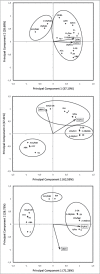Principal component analysis of hormone profiling data suggests an important role for cytokinins in regulating leaf growth and senescence of salinized tomato
- PMID: 20592807
- PMCID: PMC2835956
- DOI: 10.4161/psb.5.1.10120
Principal component analysis of hormone profiling data suggests an important role for cytokinins in regulating leaf growth and senescence of salinized tomato
Abstract
High throughput analytical methods allow phytohormonal profiling, but the magnitude of the data generated makes it difficult to draw firm conclusions about the physiological roles of different compounds. Principal component analysis (PCA) was used as a mathematical tool to evaluate relationships between physiological and hormonal variables in two experiments with salinised tomato. When tomato plants (cv Boludo F1) were grafted onto a recombinant inbred line (RIL) population derived from a Solanum lycopersicum x S. cheesmaniae cross and grown under moderate salinity (75 mM NaCl) for 100 days under greenhouse conditions, PCA revealed an important role for leaf xylem cytokinins (CKs) in controlling leaf growth and photosystem II efficiency (Fv/Fm) and thus crop productivity under salinity. PCA analysis from a similar experiment, with ungrafted tomato grown under highly saline (100 mM NaCl) conditions, that evaluated the temporal sequence of leaf growth (as relative growth rate, LRGR) and senescence and hormone concentrations, revealed a similar influence of CKs on both processes, since Fv/Fm and LRGR were strongly loaded along the two principal components and placed in the same cluster as leaf trans-zeatin and/or related to other CK-related parameters. The conservative behaviour of the eigen vectors for Fv/Fm and the analyzed phytohormones in different compartments (xylem, leaf and root) between different experiments suggests an important role for CKs in regulating leaf senescence, while CKs and other hormones seem to regulate leaf growth under salinity.
Keywords: cytokinins; leaf growth; principal component analysis; salinity; senescence; tomato.
Figures

Comment on
-
Rootstock-mediated changes in xylem ionic and hormonal status are correlated with delayed leaf senescence, and increased leaf area and crop productivity in salinized tomato.Plant Cell Environ. 2009 Jul;32(7):928-38. doi: 10.1111/j.1365-3040.2009.01973.x. Epub 2009 Mar 3. Plant Cell Environ. 2009. PMID: 19302168
References
-
- Davies WJ, Zhang J. Root signals and the regulation of growth and development of plants in drying soil. Ann Rev Plant Physiol Plant Mol Biol. 1991;42:55–76.
-
- Dodd IC. Root-to-shoot signalling: Assessing the roles of ‘up’ in the up and down world of long-distance signalling in planta. Plant Soil. 2005;274:251–270.
-
- Birkemeyer C, Kolasa A, Kopka J. Comprehensive chemical derivatization for gas chromatography-mass spectrometry-based multi-targeted profiling of the major phytohormones. J Chromatogr. 2003;993:89–102. - PubMed
-
- Pan XQ, Welti R, Wang XM. Simultaneous quantification of major phytohormones and related compounds in crude plant extracts by liquid chromatography-electrospray tandem mass spectrometry. Phytochemistry. 2008;69:1773–1781. - PubMed
-
- Joliffe IT. Principal Component Analysis. New York: Springer,; 2002. p. 502.
Publication types
MeSH terms
Substances
LinkOut - more resources
Full Text Sources
Research Materials
